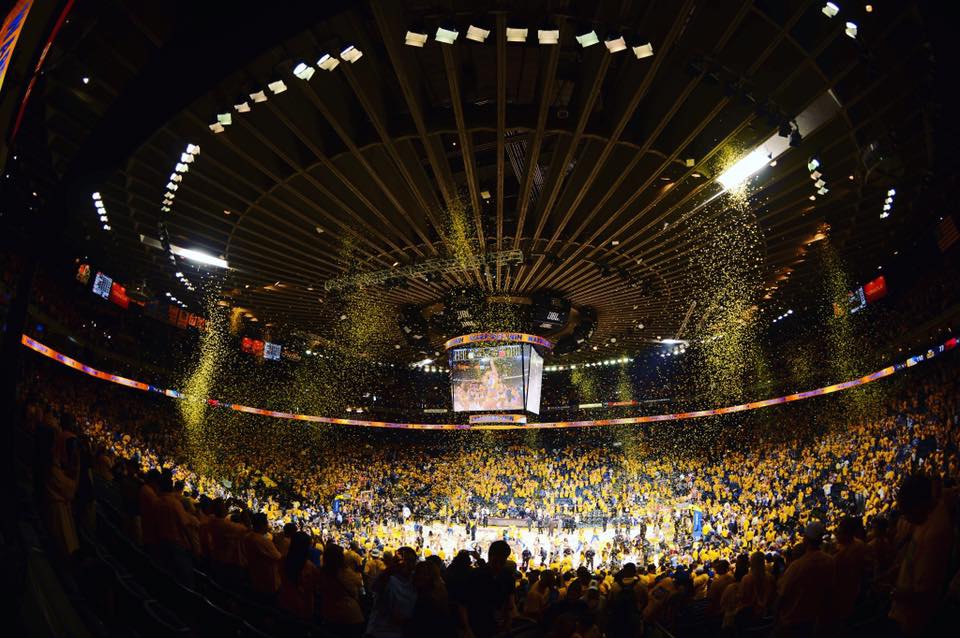Talk about a late bloomer.
In 2016, there is no more famous home court in the NBA than Oracle Arena in Oakland. The home of the Golden State Warriors, Oracle Arena not only hosted an NBA championship in 2015 — and nearly did it again in ’16 — it is now home to the reigning record-holders for the greatest single season in NBA history. En route to their all-time mark of 73 wins, the Warriors went 39-2 at Oracle, the second-best mark in league history for regular-season home victories, trailing only the 2015-16 San Antonio Spurs Spurs and 1985-86 Boston Celtics, who each went 40-1.
These past two seasons have made Oracle Arena a destination locale in professional sports, and it is only fitting that Oracle has finally gotten its due, as 2016 marks its 50th anniversary in existence. It’s true what they say: Life does start at 50.
In a league that attributes much of its mystique to the classic arenas of its greatest teams – the old Boston Garden, Madison Square Garden, Chicago Stadium and the Fabulous Forum – the Oracle holds the current distinction as the oldest arena in the NBA.
But the building, originally adorned with the catchy moniker Oakland-Alameda County Coliseum Arena, was not originally built for basketball. It wasn’t even the primary structure at its location. The arena was a secondary element to the construction of the Oakland-Alameda County Coliseum, future home of the Oakland Raiders in the AFL and Oakland Athletics in Major League Baseball.
The city of Oakland, looking to compete with neighboring San Francisco as a thriving city with modern amenities and economic and social opportunities, turned to professional sports as a vehicle for progress and in 1960 began planning for a multi-sport complex near the newly-built Nimitz Highway in East Oakland. Construction began on the $25 million project in 1962 and the Coliseum and arena were ready to open in 1966.
The Arena opened with an original seating capacity of 13,502, and its first tenant was a hockey team.
By the mid-1960s, the National Hockey League had decided to make a major expansion across the United States, adding teams in Philadelphia, Pittsburgh, Minnesota, St. Louis and the two major California cities, Los Angeles and San Francisco.
San Francisco already had a professional hockey team called the Seals in the Western Hockey League (WHL), playing their home games at the Cow Palace, located on the San Francisco side of the bay.
But in order to satisfy the NHLs expansion plans, the Seals changed their name to a more area-generic California Seals, and moved across the bay to the just-built Oakland-Alameda Arena. On November 9, 1966, the Seals, still playing in the WHL, hosted their first game in the new arena and in 1967 formally joined the NHL.
Basketball also called the arena home in 1967 with the arrival of the American Basketball Association’s Oakland Oaks. Although they played in Oakland for just two seasons, the Oaks personified everything that was the free-wheeling alternative league to the establishment NBA.
Owned by singer Pat Boone and having lured NBA star Rick Barry to its roster, the Oaks won 60 games in 1968-69 and captured the ABA championship. But while lagging attendance forced Boone to sell the Oaks after the 1969 season, the NBA took notice and moved the San Francisco Warriors out of the Cow Palace after the 1970-71 season and relocated the franchise to Oakland, changing the name to Golden State.
Although the team did not begin playing at Oakland-Alameda County Coliseum Arena until 1971, the building is still considered the NBAs oldest arena, as it opened two years before the current version of New York’s Madison Square Garden, which has hosted the Knicks since it opened in 1968.
The Warriors enjoyed early success in the arena, with Barry returning to the franchise and leading the Warriors to the 1975 NBA title. The arena would also become the host for a cornucopia of sports teams and entertainers. Between 1966 and ‘95, the arena was home to a World Tennis Team (Golden Gaters 1974-78), indoor soccer (Earthquakes 1982-84) and two roller derby franchises, the Bay Bombers (1966-73) and Oakland Skates (1993-95).
The arena was also the home to 66 Grateful Dead concerts, the most in any one building for the iconic Bay Area band.
But as the Warriors’ early success waved, the arena also found itself in a state of steady decline. Finally, in 2006, the arena underwent a $121 million renovation that would see its seating capacity for basketball increase to 19,596, as well as changing the name to Oracle Arena.
The renovations coincided with a change in the Warriors’ fortunes, as they again became an annual playoff contender, culminating with the NBA title in 2015.
But the new success late in life is bittersweet for the old building. Plans are already underway for a new arena back on the San Francisco side of the bay. If the Warriors can fend off current legal challenges, the Chase Center could open in 2019, bringing the Warriors back to their original roots and bringing an end to the Era of Oracle.
Image courtesy of the Golden State Warriors.
This article originally appeared in the weekly Arena Digest newsletter. Are you a subscriber? Click here to sign up for the free weekly newsletter.


